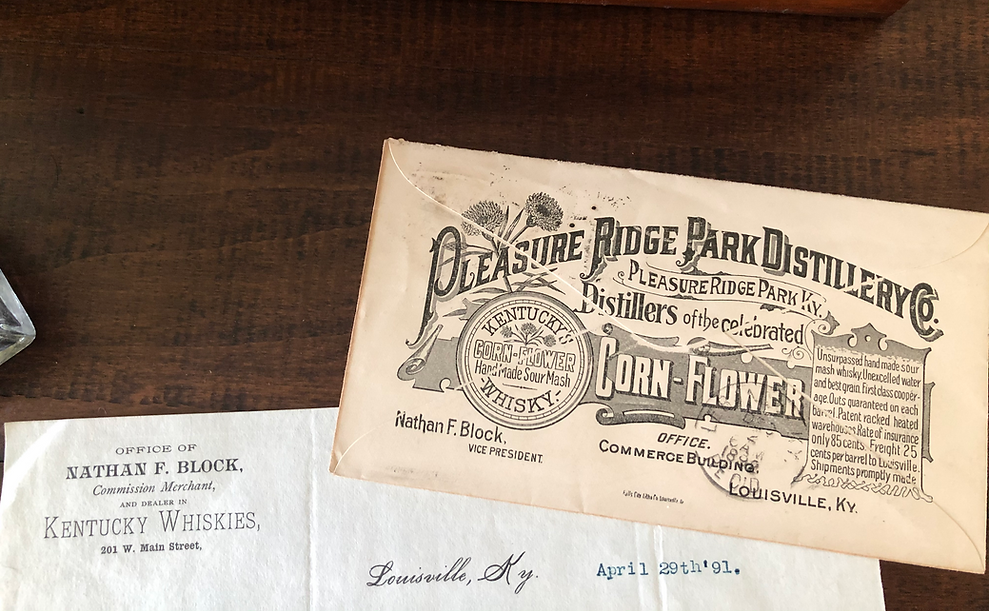
the family tree
Steeped in rich Kentucky bourbon heritage as deep as Mammoth Cave, and as broad and winding as the Ohio River. Our origin story is more than 140 years in the making, and like so many other stories, it begins with a dream.
1854 in pursuit of the American Dream
When Nathan F. Block immigrated to the United States in 1854 at the age of 10, hope and opportunity were the pillars of the American dream. With an unrelenting work ethic, his father, Moses, instilled in him the belief that anything was possible if you were willing to work hard enough for it. Moses built a good life for his family. His example was not wasted on young Nathan.

Nathan is here
1881 Louisville, Kentucky
Nathan Block first opened a whiskey wholesaler and brokerage on Whiskey Row, at 144 West Main street near where Merle's Whiskey Kitchen is today.
The wholesale business would soon grow to become Block, Franck & Co.
1882
Nathan quickly developed a reputation for having an exceptionally good taste in Bourbon, and his whiskey was sought far and wide.
Over the next decade N.F. Block registered 5 new whiskey brands:
-
Kentucky Oaks
-
Old Thoroughbred
-
Kentucky Derby
-
University Club
-
Cornflower
Enterprise


1890 Partnering with a Whiskey Legend
As demand for his Bourbon grew, so did his ambitions. In 1890 Nathan Block partnered up with brothers Bernard & Isaac W. Bernheim, and together they purchased the Pleasure Ridge Park Distillery. Bernard Bernheim was named President and Nathan Block was Vice President.
With a capacity of 10,000 gallons/day, the distillery crafted some of the finest whiskies, bourbons, and rye's. Originally registered as distillery No. 29, it was re-numbered as distillery No. 413, 5th district.

Waste Not...
Life is never without its challenges. That same year, one of the warehouses holding more than 12,500 barrels collapsed, flooding the countryside and swelling the ditches with whiskey.
Legend says the local livestock have yet to sober up.

1891
When Nathan F. Block entered the whiskey trade in the 1880’s, he faced fierce competition. Louisville, Kentucky’s bourbon and rye distilling scene was booming, and many fine brands had already been established.
If Block was going to succeed, he would need to find a way to stand out from the crowd. In 1891 he trademarked the Cornflower and University Club brands. They built two new warehouses, each with 10,000 barrel capacity. Their cutting edge warehouses – for the time – utilized the recently patented heated vertical racks, giving them a competitive advantage in creating a world class whiskey.

1896 Catastrophe Strikes
In March of 1896 another round of bad luck strikes the Pleasure Ridge Park Distillery. This time with graver consequences than a few tipsy cows. While Block was in New Orleans attending to business, a horrible fire broke out back home at the distillery.
It started as an ember from a smokestack that landed on the roof of one of the warehouses. In less than 10 minutes, the flames spread to the barrels on the upper floor, causing them to explode and sending flaming whiskey everywhere. 30,000 barrels of whiskey were lost.

1897
Bernheim’s modest losses were quickly covered by insurance, and he immediately set about constructing a new distillery plant at 7th and Bernheim Lane. Nathan Block, however, endured a far more lengthy and arduous struggle to recoup his losses.
The government claimed that Nathan Block and Isaac Bernheim owed $1,000,000 in taxes on the lost liquor. That is roughly $31 million today!
They fought it for more than a year, and after much adversity, they prevailed. The day before Thanksgiving in 1897, the Secretary of the Treasury canceled the bond, abating the tax, and effectively freeing the Blocks and Bernheims of any further liability.


While many a lesser spirit might have thrown in the towel, it was not in his nature. From the ashes he lifted himself, soon turning calamity to victory with the acquisition of the newly rebuilt distillery.
At long last, Nathan Block had finally become the sole owner of his own distillery; a bourbon king of his own making! For the remainder of his years in the business, he dedicated himself to the perfection of his liquor brands until his retirement in 1903. By this point he had indelibly left his mark in the annals of bourbon history.
Block's whiskey brands continued to enjoy robust national distribution via his son’s aptly named “Block Bros” whiskey wholesale and brokerage business for nearly 20 years until the onset of Prohibition.

1935 Prohibition
After the end of prohibition, W. L. Weller & Sons re-registered “Kentucky Oaks” and Stitzel-Weller re-registered “University Club” under their own brands.
They are the only records of the role Nathan F. Block played in Kentucky Bourbon history...until today.



